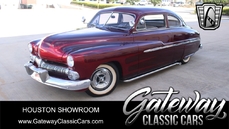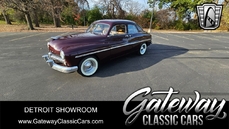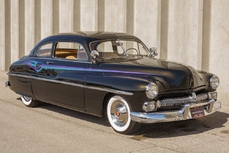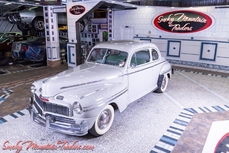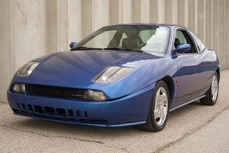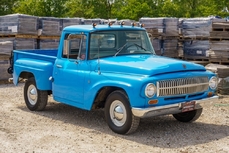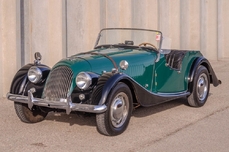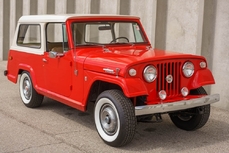Mercury Eight 239 Flathead V-8 1941
Allgemeine Beschreibung :
1941 Mercury Eight Club Convertible
Same Arizona for the past ten years
Only third model year for Mercury, which launched in 1939
One of 8,556 Club Convertibles made in 1941
239 CID Flathead V-8 engine with Edelbrock aluminum intake manifold and headers
Triple Stromberg carburetors
Three-speed manual transmission and 3.54 gearing
Mayfair Maroon exterior with red/white interior and tan, canvas folding top
Own this Vehicle from $499 per month-call 636-600-4600
Just two years after its debut, Mercury was doing its job as the bridge between the entry-level Ford and the upper crust Lincoln-Zephyr. Triple Stromberg carburetors replace the factory Holley dual downdraft unit on the Ford Flathead V-8 engine. This highly desirable Mercury convertible comes from Scottsdale Arizona and owned by the same owner for the past ten years.
Finished in Mayfair Maroon, the droptop’s paint and trim are in overall very good order with some minor blemishes and the running boards have aged rubber trim. The tan, folding canvas top is in very good shape, bodywork is straight and solid, the engine bay is exceptionally tidy, the cargo area with full-size spare tire is in very good order and the chrome bumpers look great.
This convertible rolls on Commander wide whitewall tires topped with factory wheel covers. The tires and wheel covers are in overall very good order.
Under the hood is Ford’s 239 CID Flathead V-8 with Edelbrock aluminum intake manifold and headers, dual exhausts and those trio of Stromberg carburetors. Backing up this motor are a three-speed manual transmission and a 3.54:1 rear end.
Inside the red seats with white trim are in overall great condition, as is the carpet and white, two-spoke steering wheel. The metal instrument panel and inner door liners are in excellent order. Ancillary oil, ammeter and coolant temperature gauges from Classic Instruments are mounted below the instrument panel but the fuel gauge and wipers are inoperable. The factory AM radio at the top of the dash completes the interior.
The 1941 Mercury Eight got all-new styling and some engineering improvements. The Mercury now shared its bodyshell with Ford, probably to lower Mercury production costs. Mercury’s wheelbase was expanded by two to 118 inches. There were many chassis refinements, including improved spring lengths, rates, and deflections, plus changes in shackling, shocks, and an improved stabilizer bar, but the old-fashioned transverse springs were still used.
The new body featured door bottoms that flared out over the running boards, allowing for wider seats and interiors. The car had two inches more headroom, two-piece front fenders (three-piece at first), and more glass area. The front pillars were made slimmer and the windshield was widened, deepened, and angled more steeply. Parking lights were separate and set atop the fenders for greater visibility. Headlight bezels were redesigned. In all closed Mercurys the rear-quarter windows opened out. Front vent wings were now crank-operated, and in closed, cars the ventilation wing support bars rolled down with the windows.
The four-door convertible, offered in 1940, was gone, but a station wagon was added. The Woodie wagon’s body behind the engine cowl was identical to Ford’s and produced at the company’s Iron Mountain plant in Michigan’s Upper Peninsula. The “Eight” script was moved to the rear of the hood. 90,556 Mercury Eights were sold in the 1941 model year.
Convertible competition to this Mercury in 1941 included Buick’s Super Eight, Chrysler’s New Yorker, Dodge’s Custom, Oldsmobile’s 98, Pontiac’s Deluxe Torpedo Eight.
Pre-World War II car fans, those who favor Mercurys over Ford or collectors who like something seldom seen should visit MotoeXotica Classic Cars to review this Mercury Eight Convertible. Like the Roman god for which the marque is named, we predict this car won’t linger long.
VIN: 99A299374
This car is currently located at our facility in St. Louis, Missouri. Current mileage on the odometer shows 26,166 miles. It is sold as is, where is, on a clean and clear, mileage exempt title. GET OUT AND DRIVE!!!
Click to View the 1941 Mercury Eight Club Video
Or copy & paste link below into your browser:https://youtu.be/sMYe-Xg2EKg
https://www.motoexotica.com/inventory/listing/1941-mercury-eight-club-convertible/
1941 Mercury Eight 239 Flathead V-8 is listed verkauft on ClassicDigest in Fenton (St. Louis) by for $35900.
Fakten der Auto
Karosserietyp : Auto Marke : Mercury Modell : Eight Ausführung : 239 Flathead V-8 Hubraum : 0.0 Modelljahr : 1941 Karosstyp : Convertible Lage : Fenton (St. Louis)
Verkauft
Angaben Zum Verkäufer
Verkauft
People who viewed this Mercury Eight also viewed similar Mercury listed at ClassicDigest
Other cars listed for sale by this dealer
über Mercury
Mercury, die Automarke, hat eine reiche Geschichte, die über ihre Rolle in der Anpassungs- und Hot-Rodding-Szene hinausgeht, insbesondere mit dem ikonischen Mercury Eight. Hier sind einige wichtige Punkte über Mercury:Gründung und Frühe Jahre:
Mercury wurde 1938 von der Ford Motor Company als Mittelklassemarke eingeführt und positionierte sich zwischen den erschwinglichen Ford-Modellen und der Luxus-Lincoln-Reihe. Die Marke sollte die Lücke zwischen diesen beiden Segmenten füllen.
Mercury Eight:
Der Mercury Eight, eingeführt im Jahr 1939, ist vielleicht das bekannteste Modell in der Geschichte der Marke. Er zeichnete sich durch ein elegantes Design und einen leistungsstarken V8-Motor aus. Dieses Modell wurde für die Anpassung und das Hot-Rodding populär und hat einen bedeutenden Platz in der amerikanischen Automobilkultur eingenommen.
Kultur der Anpassung:
Der Mercury Eight mit seinem unverwechselbaren Design und einem relativ erschwinglichen Preis wurde zu einem Favoriten unter den Bauherren von maßgeschneiderten Autos. Er spielte eine entscheidende Rolle in der Entwicklung der Kultur der maßgeschneiderten Autos und Hot Rods, insbesondere in der Nachkriegszeit.
Lead Sleds und Anpassung:
Der Begriff "Lead Sled" wird oft mit stark angepassten Autos aus den 1940er und 1950er Jahren in Verbindung gebracht. Diese Autos, einschließlich des Mercury Eight, wurden oft mit tiefergelegten Aufhängungen, gekürzten Dächern und anderen stilistischen Veränderungen modifiziert. Lead Sleds waren ein herausragender Bestandteil der Kultur der maßgeschneiderten Autos, und der Mercury Eight war eine beliebte Wahl für solche Modifikationen.
Wohlstand der Nachkriegszeit:
In der Nachkriegszeit erlebte Mercury, wie viele andere amerikanische Automobilhersteller, einen Aufschwung der Popularität, als die Wirtschaft florierte. Die Marke trug zur Faszination für stilvolle und leistungsstarke Autos dieser Ära bei.
Entwicklung von Modellen:
Im Laufe der Jahre produzierte Mercury verschiedene Modelle und trug so zum Angebot von Ford bei. Einige bemerkenswerte Modelle sind der Mercury Monterey, der Mercury Comet und der Mercury Cougar.
Niedergang und Einstellung:
Trotz Phasen des Erfolgs hatte Mercury Schwierigkeiten, eine eindeutige Identität neben Ford zu etablieren. Mit dem Wandel der Verbraucherpräferenzen kämpfte die Marke, und Ford kündigte schließlich 2010 die Einstellung von Mercury an.
Erbe in der Populärkultur:
Mercury, insbesondere Modelle wie der Mercury Eight, nimmt einen bedeutenden Platz in der amerikanischen Populärkultur ein. Die Verbindung zur Szene der Anpassung und des Hot-Rodding sowie das unverwechselbare Design haben einen nachhaltigen Einfluss hinterlassen.
Zusammenfassend lässt sich sagen, dass der Mercury Eight für seine Rolle in der Kultur der Anpassung und des Hot-Rodding gefeiert wird, während Mercury als Marke eine breitere Rolle in der Automobilgeschichte spielte, indem sie zum mittelpreisigen Segment beitrug und die Automobil-Trends ihrer Zeit widerspiegelte.



